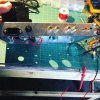thorpej
Super Member
Having cleared a couple of projects off the bench, of course it's time to start a new one. As you may recall, I built a Magnavox 8802 clone for my daughter last year for Christmas... I was planning to do the same for my son this year -- holy cow if the stuff isn't THE SAME, sometimes you sure do hear about it!  Anyway, my son has actually expressed a preference for an actual OLD amplifier, and I recently picked up another working 8802 for a song, so my plan was to refurbish that one.
Anyway, my son has actually expressed a preference for an actual OLD amplifier, and I recently picked up another working 8802 for a song, so my plan was to refurbish that one.
However, having learned a lot since my daughter's 8802, I plan to make some significant changes to the circuit.
The basic idea is "@dcgillespie 9302 + 8802 + blender", i.e. essentially copy the front end from Dave's 9302 mod (adjusting as necessary for the lower voltages on the 8802), and bolt it to a 6V6 output stage w/ the EFB cathode regulator. I have already tweaked the EFB voltage divider for typical 6V6 operating points in my Silvertone shop-amp (I just need to find my notes on that now!).
The main departure, however, is to use different output transformers. Rather than buying yet another pair of bookshelf speakers, I want to repurpose some ca. 1991 Bose 301s that were recently retired from home-office service, so 8 ohm output is required. I figured since I'm going to replace the transformers, I might go ahead and optimize the operating point a bit. The original 8802 ran the 6V6s at 250 plate / 250 screen, but used 6K OTs rather than the typical 10K (per the 6V6 data sheet). If I were to run the 6V6s at 285 / 285 and use an 8K OT, I could (conservatively) gain 30% more power over the textbook 250 / 250 operating point. I can easily improve the available high voltage by ditching the 6CA4 rectifier and using 1N4007s instead, and this is the direction I'm leaning. I'd probably just use Edcor 15W 8K OTs (the GXPP series -- they should fit on the chassis fairly easily).
Thoughts?
However, having learned a lot since my daughter's 8802, I plan to make some significant changes to the circuit.
The basic idea is "@dcgillespie 9302 + 8802 + blender", i.e. essentially copy the front end from Dave's 9302 mod (adjusting as necessary for the lower voltages on the 8802), and bolt it to a 6V6 output stage w/ the EFB cathode regulator. I have already tweaked the EFB voltage divider for typical 6V6 operating points in my Silvertone shop-amp (I just need to find my notes on that now!).
The main departure, however, is to use different output transformers. Rather than buying yet another pair of bookshelf speakers, I want to repurpose some ca. 1991 Bose 301s that were recently retired from home-office service, so 8 ohm output is required. I figured since I'm going to replace the transformers, I might go ahead and optimize the operating point a bit. The original 8802 ran the 6V6s at 250 plate / 250 screen, but used 6K OTs rather than the typical 10K (per the 6V6 data sheet). If I were to run the 6V6s at 285 / 285 and use an 8K OT, I could (conservatively) gain 30% more power over the textbook 250 / 250 operating point. I can easily improve the available high voltage by ditching the 6CA4 rectifier and using 1N4007s instead, and this is the direction I'm leaning. I'd probably just use Edcor 15W 8K OTs (the GXPP series -- they should fit on the chassis fairly easily).
Thoughts?




